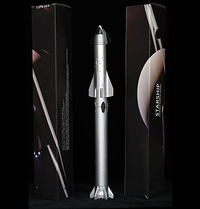SpaceX Starship megarocket launches on 2nd-ever test flight, explodes in 'rapid unscheduled disassembly' (video)
It was the second explosive moment for the biggest rocket ever built, but SpaceX hailed it as a success.
SOUTH PADRE ISLAND, Texas — SpaceX's giant Starship has met another explosive end.
SpaceX's next-generation megarocket — the largest ever built — launched on its second-ever test flight today (Nov. 18), a highly anticipated jaunt that took the giant vehicle to space for the first time, but it didn't last long. Shortly after stage separation, the rocket's massive Super Heavy booster exploded, with the Starship upper-stage vehicle itself detonating before reaching its target altitude in what SpaceX called a "rapid unscheduled disassembly."
"What we do believe right now is that the automated flight termination system on second stage appears to have triggered very late in the burn, as we were headed downrange out over the Gulf of Mexico," said John Insprucker, SpaceX's principal integration engineer, during a live webcast today.
The massive Starship and Super Heavy booster took off today at about 8 a.m. EDT (1300 GMT; 7 a.m. local Texas time) from SpaceX's Starbase test and manufacturing facility in Boca Chica.
Just north of Boca Chica, here on South Padre Island, spectators gathered by the hundreds this morning to watch the launch. They cheered as the orange light from Starship's 33 first-stage Raptor engines blazed through its plume of exhaust as the huge rocket began its climb. Standing nearly 400 feet (122 meters) tall, Starship is the largest and most powerful rocket ever built, and it can be seen for miles when stacked and standing at the Starbase launch pad.
Related: See stunning photos and video of Starship's 2nd launch
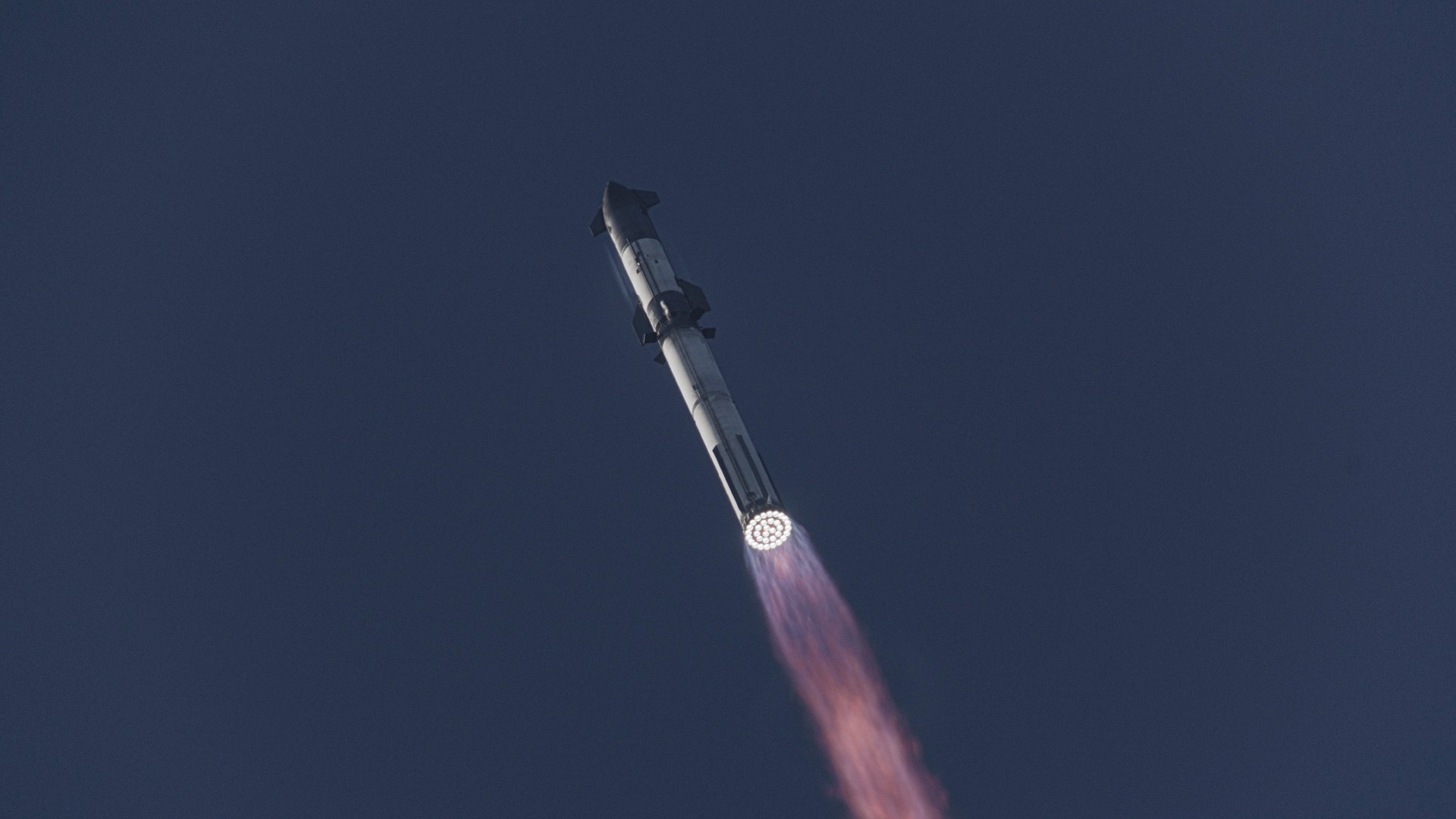
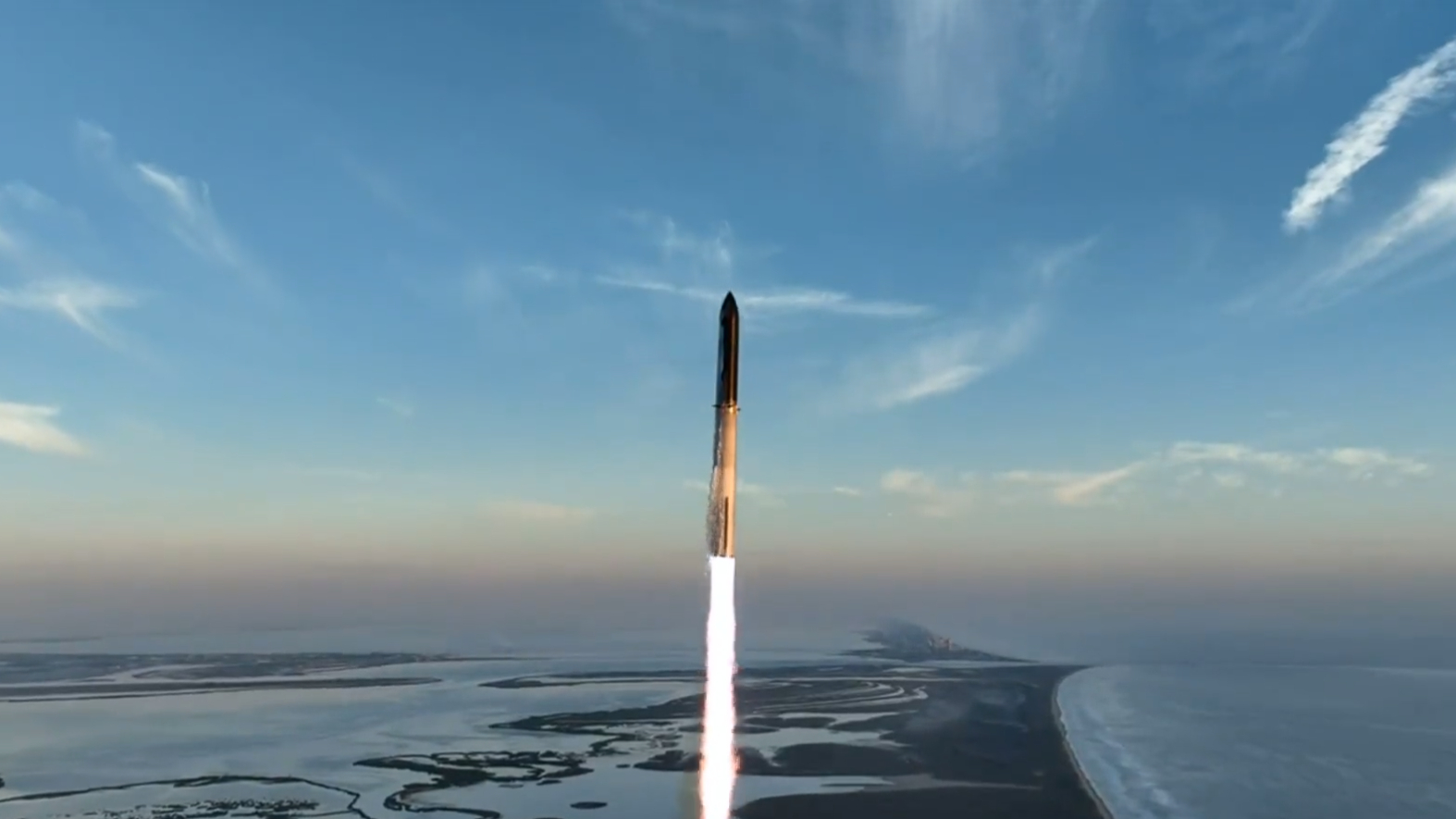
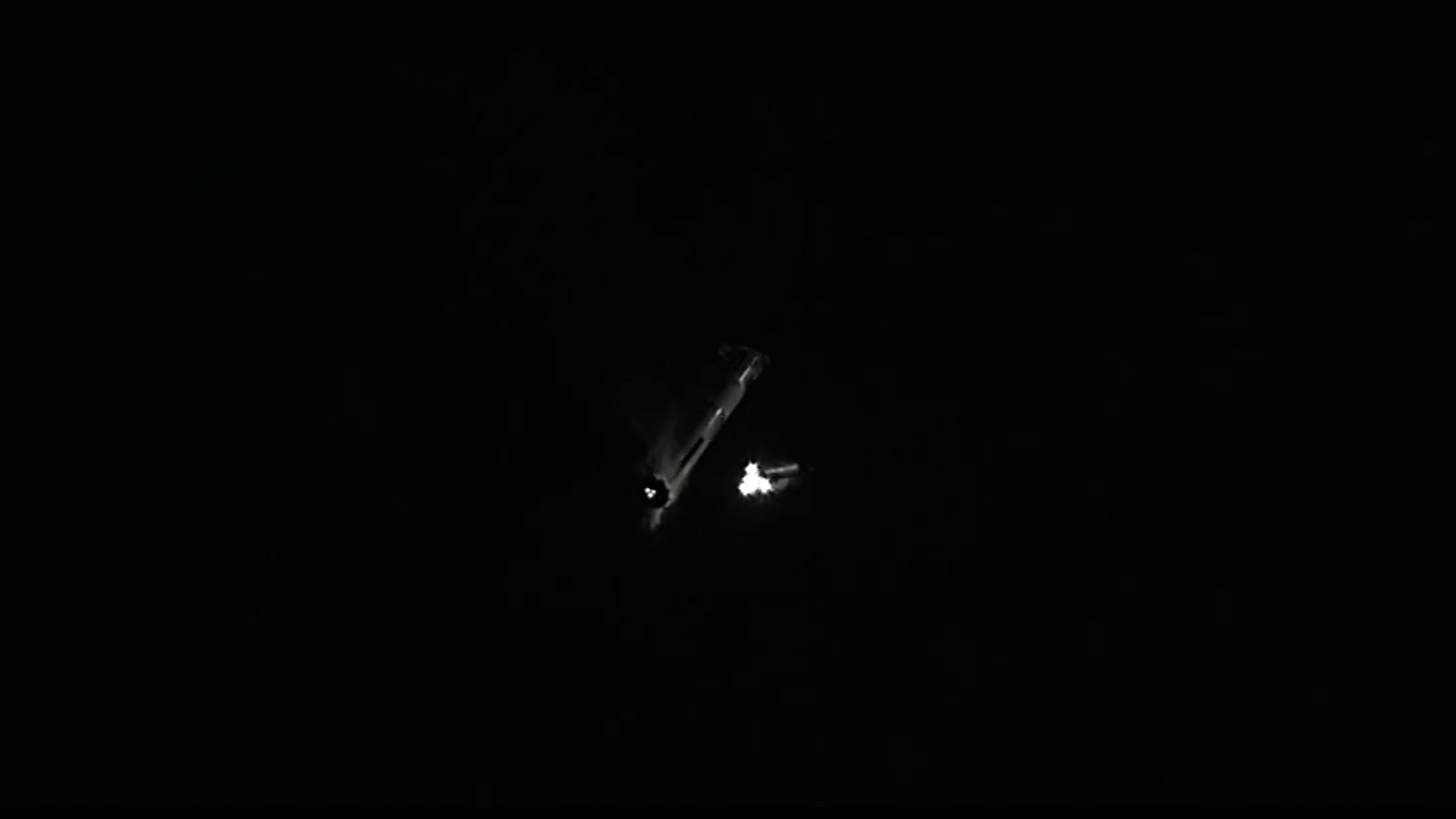
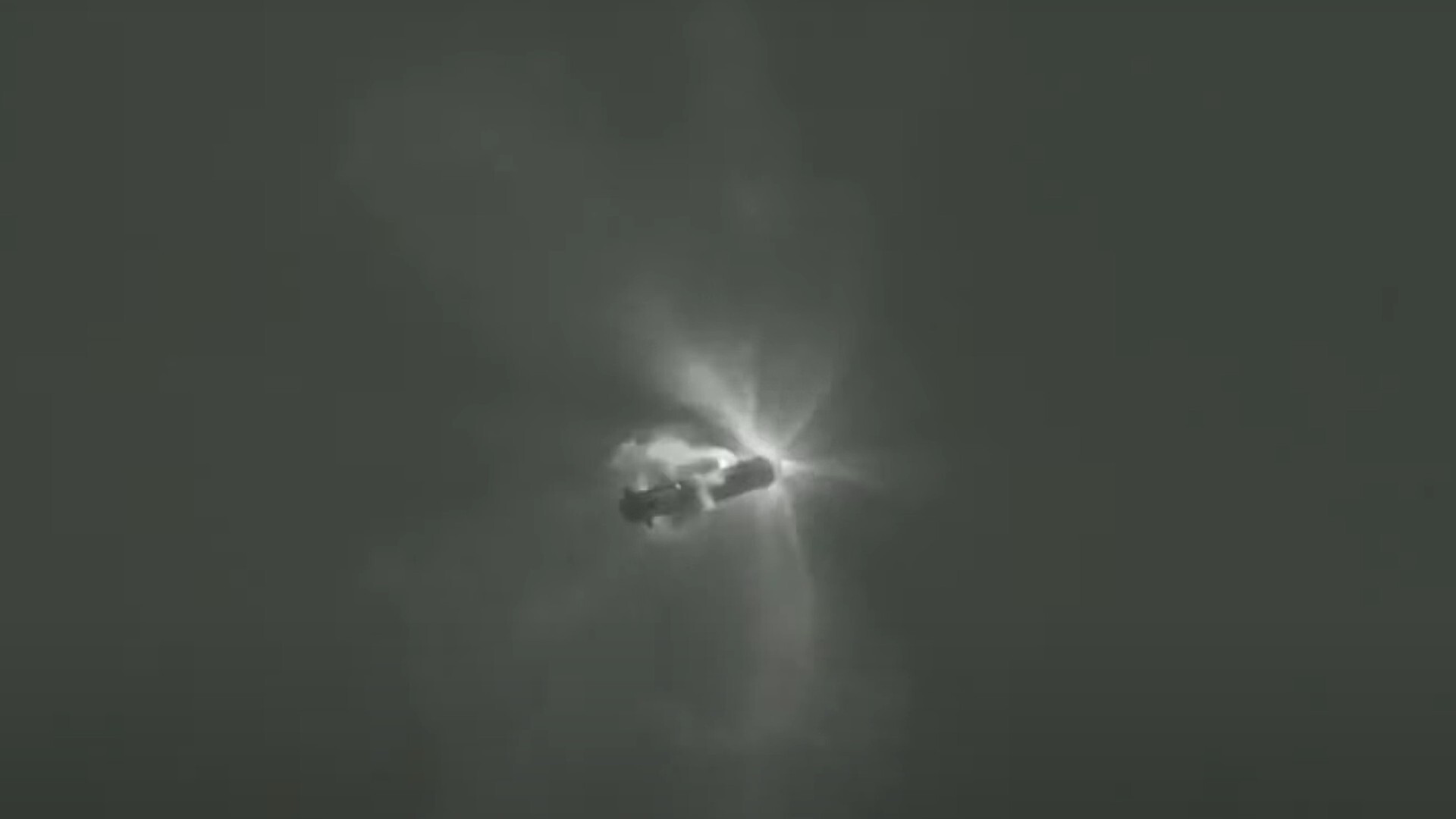

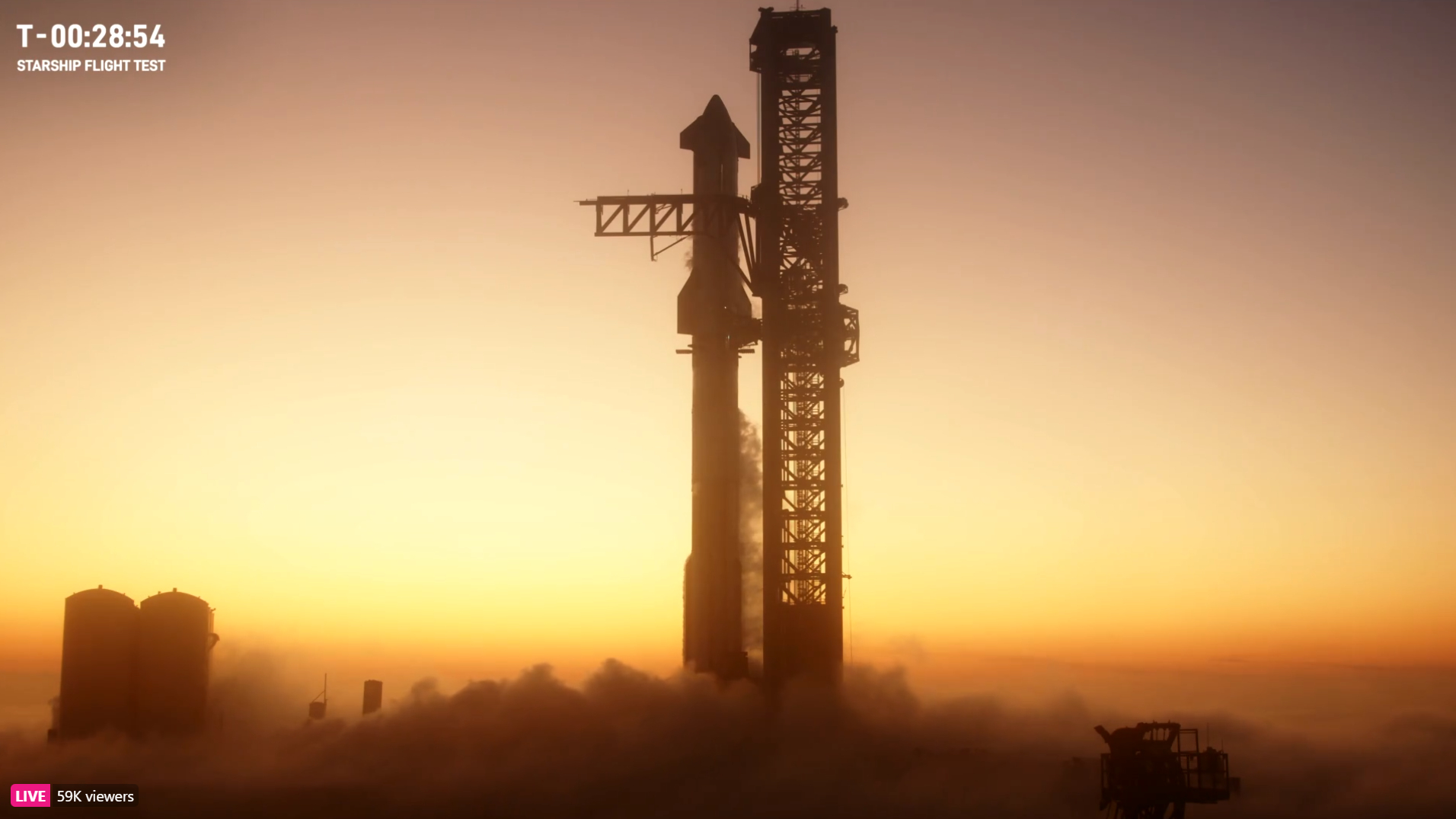
Starship Die Cast Rocket Model Now $69.99 on Amazon.
If you can't see SpaceX's Starship in person, you can score a model of your own. Standing at 13.77 inches (35 cm), this is a 1:375 ratio of SpaceX's Starship as a desktop model. The materials here are alloy steel and it weighs just 225g.
Note: Stock is low so you'll have to act quickly to get this.
This was the second test flight for the fully integrated Starship, which consists of the Super Heavy first-stage booster and Starship upper-stage spacecraft. The first liftoff, which occurred on April 20 of this year, did not go as well as this one did. April's Starship launch ended with a self-destruct command about four minutes into flight, turning the tumbling rocket into a smoldering fireball.
Breaking space news, the latest updates on rocket launches, skywatching events and more!
One reason for April's unscheduled disassembly was the failure of Starship's two stages to separate. To prevent a recurrence of this problem on the second flight, SpaceX decided to go with a new strategy: "hot staging," in which the upper stage's engines begin firing before Starship and Super Heavy have fully separated. This concept isn't new; it has been used on vehicles like the Titan II from NASA's Gemini program in the 1960s and Russia's venerable Soyuz rocket, which is still in operation.
Starship's stage separation occurred on time today, about 2 minutes and 41 seconds after liftoff, and appeared to go smoothly, but the Super Heavy booster exploded shortly afterward.
"We're going to take that data and improve the hot staging sequence and probably improve the hardware itself for the next flight," SpaceX quality engineering manager Kate Tice said during the live webcast. SpaceX had hoped to soft-land the Super Heavy in the Gulf of Mexico to test reentry and landing processes.
Related: NASA chief congratulates SpaceX on Starship's 2nd launch test
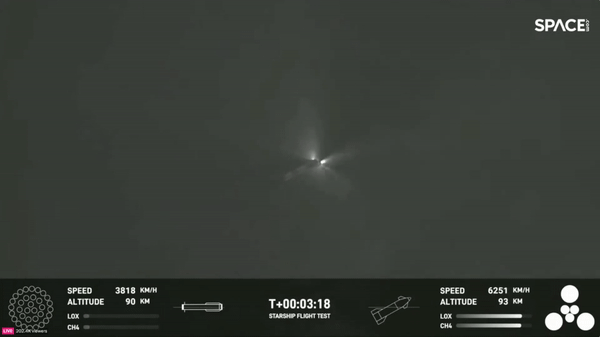
The Starship upper stage continued flying for a short time after stage separation. SpaceX had hoped to establish signal acquisition with the spacecraft at its target altitude of about 150 miles (250 kilometers). But telemetry from the vehicle was lost about eight minutes after liftoff, near the end of its own burn after stage separation, with SpaceX mission managers, including CEO and founder Elon Musk, eagerly awaiting updates in a live webcast.
The spacecraft was never expected to reach full orbit around Earth, instead flying on a suborbital trajectory to splash down in the Pacific Ocean off the coast of Hawaii. "We're not targeting orbit today; we're targeting almost orbit," said Siva Bharadvaj, a SpaceX operations engineer, adding that the goal was to "get to a thrust profile similar to what we would need for orbit, but also energy level that the ship would need to dissipate for reentry."
It's worth nothing that Starship's second test mission did fly longer and higher than its first test flight on April 20, which failed at stage separation and exploded. So SpaceX still considered the second try a success. The last telemetry signal from today's launch pegged Starship's altitude at 148 kilometers, or 91 miles, well above the 62-mile (100 km) boundary of space.
"Honestly, it's such an incredibly successful day even though we did have a rapid unscheduled disassembly of both the Super Heavy booster and the Ship," Tice said. "That's great. We got so much data, and that will all help us to improve for our next flight."
SpaceX and the crowds of spectators here at South Padre Island weren't the only ones cheering on Starship today. A lot is riding on the success of SpaceX's new rocket, including the timeline for NASA's return of astronauts to the surface of the moon.
For example, the space agency chose Starship as the lunar lander for its Artemis 3 mission, which is scheduled to carry astronauts to the moon in late 2025 or early 2026. And SpaceX's plans for the huge rocket extend well beyond the moon.
Related: Facts about NASA's Artemis program
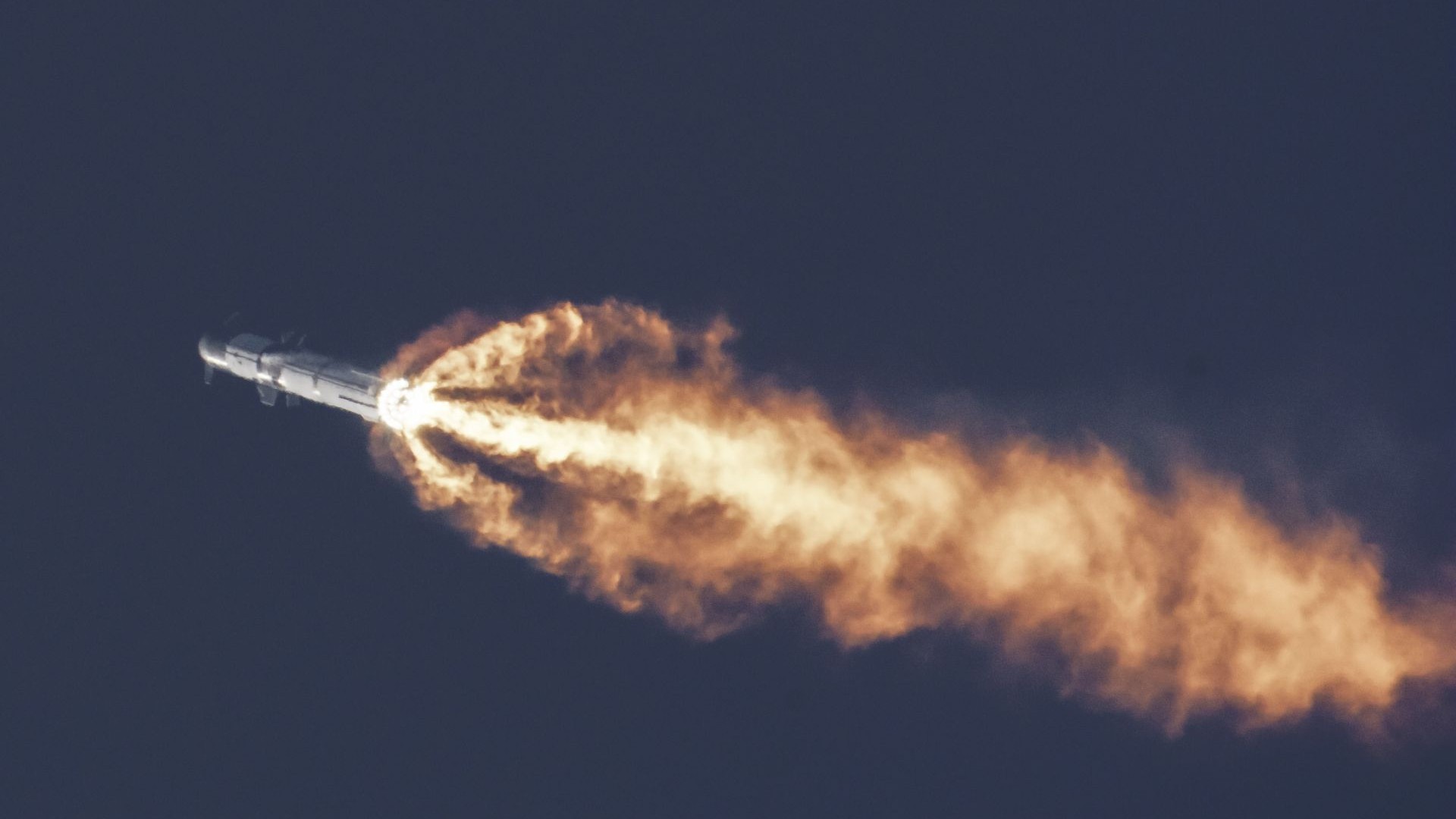
When Musk first introduced the Starship concept, he called it the Mars Colonial Transporter. When fleshing out details of the system at the International Astronautical Congress in September 2016, he announced a new name: the Interplanetary Transport System.
As these former monikers show, the new spacecraft is designed to help make humanity an interplanetary species — a long-held dream of Musk's. Though the timeline seems to continually shift from year to year, the billionaire entrepreneur envisions Starship as the vehicle that will allow humanity to establish a sustainable, permanent presence off Earth.
The breakthrough that could make that happen is Starship's reusability. The new system stands as the evolutionary next step beyond SpaceX's Falcon 9 rocket, which now regularly launches with previously flown boosters. However, only the Falcon 9's first stage and payload fairings are reusable — and reuse usually takes a few weeks at a minimum. The Falcon 9's second stage is not reusable and is disposed of after each flight.
Starship, on the other hand, is designed to be fully and rapidly reusable. The rocket's launch tower features two massive "chopstick" arms designed to catch Super Heavy as it returns to the launch pad for landing, and also to stack a landed Starship back onto Super Heavy for reflight.
Starship's launch today was hoped to lead to an uptick in launch cadence for new vehicle, as further refined designs make their way to the launch pad at Starbase. Currently, Starship's test iterations don't include any of the cabin or life-support components needed to carry a payload or sustain a crew, but SpaceX is betting big on the rocket's success. However, SpaceX will now have to investigate the causes of today's Starship disassembly, and take measures to prevent the same thing from happening again in the future.
Infrastructure to support Starship launches from NASA's Kennedy Space Center (KSC) in Florida have been underway for the past couple years, and SpaceX plans to utilize their facilities at KSC once Starship is flying regularly. A Starship launch tower has been built at Launch Complex-39A (LC-39A) at KSC, and a crew access arm added to the tower at LC-41 to support Falcon 9 crew launches from multiple pads once Starship launches move to the Cape.
Moving forward, SpaceX may aim to fly Starship test missions as often as once a month, which, if maintained, would go a long way toward certifying the vehicle for crewed launches in time for Artemis 3. SpaceX's Falcon 9 rocket has launched more than once a week, on average, the past few years, and reaching a higher cadence for the company's new launch vehicle has always been the goal.
As Starship has evolved through its development stages, Musk has touted the vehicle's capabilities for rapid reusability, and hopes to see the same vehicles launching, landing, and relaunching multiple times a day, eventually amounting to possibly hundreds of Starship launches every week.
Join our Space Forums to keep talking space on the latest missions, night sky and more! And if you have a news tip, correction or comment, let us know at: community@space.com.

Josh Dinner is the Staff Writer for Spaceflight at Space.com. He is a writer and photographer with a passion for science and space exploration, and has been working the space beat since 2016. Josh has covered the evolution of NASA's commercial spaceflight partnerships and crewed missions from the Space Coast, as well as NASA science missions and more. He also enjoys building 1:144-scale model rockets and human-flown spacecraft. Find some of Josh's launch photography on Instagram and his website, and follow him on X, where he mostly posts in haiku.
-
Unclear Engineer Watched it live. Really great to see all 33 Raptor engines burning all the way to stage separation, and all 6 on StarShip burn as well, after the stresses of boosted launch and stage separation by the "hot" process.Reply
It was a surprise to see Starship fail to achieve its intended engine cutoff point before exploding - it had burned well for almost all of its intended time. I hope SpaceX got the needed telemetry to find out why that happened. But, it seems that they were not getting telemetry at that point, and it took a while for them to conclude that the Flight Termination System had activated to destroy StarShip.
It will also be interesting to see how the launch pad held up. There is some chatter elsewhere about denting to one of the tanks in the tank farm near the pad.
Hoping for a follow-up article from Space.com soon that tells us what is actually known.
And hoping that the FAA did not see anything that it wants to "investigate" for another 7 months. -
TEAMSWITCHER Reply
Don't blame the FAA for doing their job. The first launch was a complete failure, a mini environmental catastrophe followed by complete loss of flight control, and a flight termination system that basically failed.Unclear Engineer said:Watched it live. Really great to see all 33 Raptor engines burning all the way to stage separation, and all 6 on StarShip burn as well, after the stresses of boosted launch and stage separation by the "hot" process.
It was a surprise to see Starship fail to achieve its intended engine cutoff point before exploding - it had burned well for almost all of its intended time. I hope SpaceX got the needed telemetry to find out why that happened. But, it seems that they were not getting telemetry at that point, and it took a while for them to conclude that the Flight Termination System had activated to destroy StarShip.
It will also be interesting to see how the launch pad held up. There is some chatter elsewhere about denting to one of the tanks in the tank farm near the pad.
Hoping for a follow-up article from Space.com soon that tells us what is actually known.
And hoping that the FAA did not see anything that it wants to "investigate" for another 7 months.
This second test was better, but also rather disappointing. The Artemis schedule is as slow as can be, but at this pace, SpaceX meeting that slowed down schedule is seriously in doubt. The problem is that SpaceX is still trying to get the EASY part working. There are already pictures showing severe heat shield loss just a few minutes after liftoff. That heatshield would NEVER have survived a re-enty. SpaceX isn't close with Starship.. In fact, they are dealing with all the same problems NASA had with the Space Shuttle, and some new ones too. -
Hypocee Almost all of this is good but I'm disappointed by "The Starship upper stage continued flying for a short time after stage separation." The upper stage flew steadily and on-trajectory for almost its entire planned burn, and it's likely we'll find that its failure was related to some preparation for engine shutdown in the previously untestable flight regime outside the atmosphere.Reply -
Hypocee ReplyDon't blame the FAA for doing their job. The first launch was a regulatory failure, a mini environmental catastrophe followed by separation failure after excellent and robust flight control, and a flight termination system that basically failed.
FTFY a bit but yes, we can think two things at one time. The SpaceX team is doing excellent and exciting work, and also they should never have been permitted to launch the heaviest rocket in history without a shock and erosion suppression system in place. Every commentator foresaw the demolition of the pad, and the issues it caused on the rocket and on the ground, months in advance. "A fine is a price"; the real way you make an irresponsible billionaire think twice next time is to step in and give him a few months' time out. That's what the FAA correctly did.
The problem is that SpaceX is still trying to get the EASY part working. There are already pictures showing severe heat shield loss just a few minutes after liftoff. That heatshield would NEVER have survived a re-enty. SpaceX isn't close with Starship.. In fact, they are dealing with all the same problems NASA had with the Space Shuttle, and some new ones too.
Nah. The whole point of the bellyflop and cylindrical shape is that Starship is much less dense than the Shuttle and hits at 90 degrees rather than 40 with a huge frontal shield area. This (literally, I think) exponentially reduces both the aerodynamic and thermal loads taken. There's always some degree of damage that would lead to failure in reentry, and maybe that would have been true on this flight, but Starship is incomparably more damage tolerant than the Shuttle, and overall much less complex.
Loss of thermal tiles would certainly impact the system's rapid reusability, but that's a future concern. Seeing where and how tiles stayed on or came off in unpredictable conditions was another purpose of doing an empirical test like this. SpaceX is indeed currently "trying to get the easy part working"...but they're doing so after nailing down the hard parts: Dynamically maintaining and maneuvering in the bellyflop, and relighting liquid engines under lateral g-loading. And, of course, inverted-pendulum landing, but as noted in the article they've made that routine at this point. Provided the engines turn on and don't pop, it's just different numbers in the same equations. -
DrRaviSharma Still after Saturn V and one Artemis ULA launch, this is the greatest milestone achieved by humanity.Reply
Next couple of attempts and we space human flight enthusiasts and participants will see the reliability, repeatability and confidence levels (statistically) improve towards its first goal - to land humans from lunar orbit to Moon and bring them back to orbiting station around Moon. Then more cislunar and lunar landings and one can see this as a Lunar workhorse back and forth to Earth and eventually venture deeper some day say 5 years + by extrapolation towards Mars.
Best to Spirit of SpaceX, NASA, FAA and Elon.
Ravi
(Dr. Ravi Sharma, Ph.D. USA)
NASA Apollo Achievement Award
ISRO Distinguished Service Awards
Former MTS NASA HQ MSEB Apollo time frame
Former Scientific Secretary ISRO HQ
Ontolog Board of Trustees
Particle and Space Physics
Senior Enterprise Architect
SAE Fuel Cell Tech Committee voting member for 20 years. -
Trainer Paul Great Job !Reply
Watched the launch from my home, and also on line.
It was amazing to see all engines burning like a LED light in the night. Great Job.
Was amazed about a shorter lift off time, saving fuel, less issues with the pad, and to save water.
Was surprised about the use of using water to protect the pad during lift off. Great idea.
(Pad drains would be nice, to recover the water to be reused, pumped back to the water tank)
* Note : the pad itself seems to be a cluttered, not set in a open area like N.A.S.A. used to do, tanks and equipment isn't far away and brings a little concern to my mind, I would assume this is only a test site and those issues will be taken care of in the future in a different area.
Separation is a little puzzling to me, as I would think the 1st stage would stay in a vertical position for a longer period of time to absorb the trust of the Second Stage, and then turn. Avoiding trust from the 2nd stage in a horizontal position. This would also allow slowing speeds of the 1st stage before a turn. The view in the sky from the first stage after separation was truly something I will never forget. (RUD)
Loss of communication ?
Could the separation be part of this failure as they seemed to happen not long after each other? In some ways I believe it might have been part of the plan, built to not last but one trip, recovery and reuse with salt water not the best options or cost effective for reuse. (Recommended; a black box type information gathering for on board data collection and recovery if not already being done.)
Without failure we don't learn, we all must fall before we walk. I can say this launch was truly amazing. 100% better than the last attempt.
Keep up the good work and dedication. -
billslugg Cannot allow the first stage to slow down. Any amount of slowing at stage separation puts the booster fuel at the top of the tank where it cannot get to the suction pipes supplying the engines.Reply
Hot staging requires sufficient engine power on the booster stage to offset the thrust on it by stage separation. They only had three engines, throttled down, on the booster. They may need more power to prevent sloshing. -
DrRaviSharma Reply
appreciate your analysisTrainer Paul said:Great Job !
Watched the launch from my home, and also on line.
It was amazing to see all engines burning like a LED light in the night. Great Job.
Was amazed about a shorter lift off time, saving fuel, less issues with the pad, and to save water.
Was surprised about the use of using water to protect the pad during lift off. Great idea.
(Pad drains would be nice, to recover the water to be reused, pumped back to the water tank)
* Note : the pad itself seems to be a cluttered, not set in a open area like N.A.S.A. used to do, tanks and equipment isn't far away and brings a little concern to my mind, I would assume this is only a test site and those issues will be taken care of in the future in a different area.
Separation is a little puzzling to me, as I would think the 1st stage would stay in a vertical position for a longer period of time to absorb the trust of the Second Stage, and then turn. Avoiding trust from the 2nd stage in a horizontal position. This would also allow slowing speeds of the 1st stage before a turn. The view in the sky from the first stage after separation was truly something I will never forget. (RUD)
Loss of communication ?
Could the separation be part of this failure as they seemed to happen not long after each other? In some ways I believe it might have been part of the plan, built to not last but one trip, recovery and reuse with salt water not the best options or cost effective for reuse. (Recommended; a black box type information gathering for on board data collection and recovery if not already being done.)
Without failure we don't learn, we all must fall before we walk. I can say this launch was truly amazing. 100% better than the last attempt.
Keep up the good work and dedication. -
DrRaviSharma Reply
You may be right, thanks.billslugg said:Cannot allow the first stage to slow down. Any amount of slowing at stage separation puts the booster fuel at the top of the tank where it cannot get to the suction pipes supplying the engines.
Hot staging requires sufficient engine power on the booster stage to offset the thrust on it by stage separation. They only had three engines, throttled down, on the booster. They may need more power to prevent sloshing.
